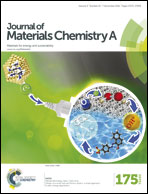Carbon-coated Si micrometer particles binding to reduced graphene oxide for a stable high-capacity lithium-ion battery anode†
Abstract
Micrometer Si (MSi) particles are an attractive alternative as high energy-density lithium-ion battery anodes. To maintain the structural integrity and resolve the electrical conduction problem of MSi-based anodes, we propose novel MSi/C/reduced graphene oxide (RGO) through simple ball milling liquid polyacrylonitrile (PAN) with MSi and graphene oxide nanosheets, followed by thermal reduction. This structure capitalizes on the interaction of MSi and carbonized PAN with RGO sheets to provide a robust microarchitecture. The mechanical integrity of the in situ formed porous configuration can be dramatically improved by manipulating the size of unreacted Si nanocrystals. In addition, the Si–N–C layer serves as an electrolyte blocking layer, which helps to build a stable SEI layer and results in a high initial coulombic efficiency of 91.7%. Furthermore, the RGO binding to MSi/C acts as a flexible buffer during galvanostatic cycling, allowing microparticles to expand and fractured nanoparticles to anchor, while retaining electrical connectivity at both the particle and electrode levels. As a result, this hierarchical structure exhibits a superior reversible capacity of 1572 mA h g−1 with no capacity loss for 160 cycles at 0.2 A g−1 and over 628 mA h g−1 for 1000 cycles at 2 A g−1.


 Please wait while we load your content...
Please wait while we load your content...